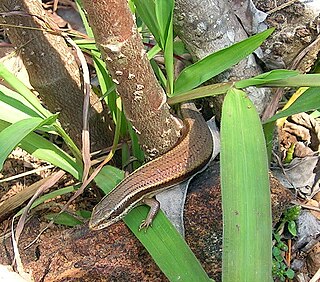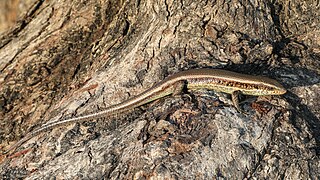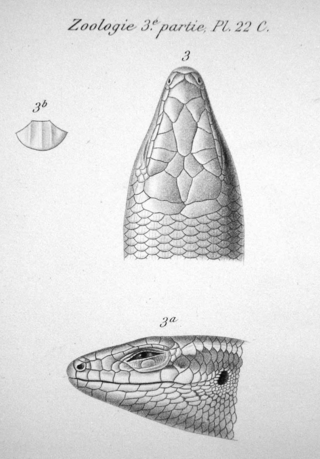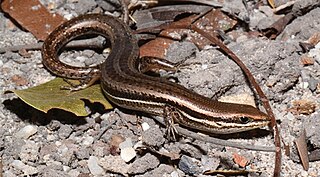Euprepis is an obsolete genus of skinks in the subfamily Lygosominae. It was named by Wagler in 1830 and frequently used in subsequent years, often misspelled as Euprepes, a misspelling introduced by Wiegmann in 1834. It was then subsumed under the large skink genus Mabuya, until Mausfeld and others resurrected it for a group of mainly African skinks they split from Mabuya. The following year, Bauer argued that this assignment had been in error and that this group should be called Trachylepis instead. Euprepis itself is a junior synonym of Mabuya.

Mabuya is a genus of long-tailed skinks, lizards in the family Scincidae. The genus is restricted to species from various Caribbean islands. Species in the genus Mabuya are primarily carnivorous, though many are omnivorous. The genus is viviparous, having a highly evolved placenta that resembles that of eutherian mammals. Formerly, many Old World species were placed here, as Mabuya was a kind of "wastebasket taxon". These Old World species are now placed in the genera Chioninia, Eutropis, and Trachylepis. Under the older classification, the New World species were referred to as "American mabuyas", and as of 2024 include the genera Alinea, Aspronema, Brasiliscincus, Capitellum, Copeoglossum, Maracaiba, Marisora, and Varzea.

Eutropis bibronii, also known commonly as Bibron's mabuya, Bibron's skink, and the seashore skink, is a species of lizard in the family Scincidae. The species is native to India and Sri Lanka.
Eutropis dawsoni, also known commonly as Gans's grass skink and Gans's mabuya, is a species of lizard in the family Scincidae. The species is endemic to the southern Western Ghats, India.

Trachylepis is a skink genus in the subfamily Mabuyinae found mainly in Africa. Its members were formerly included in the "wastebin taxon" Mabuya, and for some time in Euprepis. As defined today, Trachylepis contains the clade of Afro-Malagasy mabuyas. The genus also contains a species from the Brazilian island of Fernando de Noronha, T. atlantica, and may occur in mainland South America with Trachylepis tschudii and Trachylepis maculata, both poorly known and enigmatic. The ancestors of T. atlantica are believed to have rafted across the Atlantic from Africa during the last 9 million years.

Lygosominae is the largest subfamily of skinks in the family Scincidae. The subfamily can be divided into a number of genus groups. If the rarely used taxonomic rank of infrafamily is employed, the genus groups would be designated as such, but such a move would require a formal description according to the ICZN standards.

Eutropis is a genus of skinks belonging to the subfamily Mabuyinae. For long, this genus was included in the "wastebin taxon" Mabuya; it contains the Asian mabuyas. They often share their habitat with the related common skinks (Sphenomorphus), but they do not compete significantly as their ecological niches differ. This genus also contains the only member of the subfamily to occur in Australasia, the many-lined sun skink, whose wide range includes New Guinea.

The Noronha skink is a species of skink from the island of Fernando de Noronha off northeastern Brazil. It is covered with dark and light spots on the upperparts and is usually about 7 to 10 cm in length. The tail is long and muscular, but breaks off easily. Very common throughout Fernando de Noronha, it is an opportunistic feeder, eating both insects and plant material, including nectar from the Erythrina velutina tree, as well as other material ranging from cookie crumbs to eggs of its own species. Introduced predators such as feral cats prey on it and several parasitic worms infect it.

Trachylepis maculata, the spotted mabuya, is a species of skink in the genus Trachylepis recorded from Demerara in Guyana, northern South America. It is placed in the genus Trachylepis, which is otherwise mostly restricted to Africa, and its type locality may be in error. It is an unstriped, olive-brown, grayish animal, with dark spots all over the body. Its taxonomic history is complex due to confusion with Trachylepis atlantica from the Atlantic Ocean island of Fernando de Noronha and doubts regarding its type locality.
Trachylepis tschudii is an enigmatic skink, purportedly from Peru. First described in 1845 on the basis of a single specimen, it may be the same as the Noronha skink (T. atlantica) from Fernando de Noronha, off northeastern Brazil. T. tschudii represents one of two doubtful records of the otherwise African genus Trachylepis on mainland South America; the other is T. maculata from Guyana.
Saurocytozoon is a genus of parasitic alveolates. They infect reptiles and are thought to be transmitted by mosquitoes. Only two species have been described to date. Their relationship with the other members of this order is not presently clear.

Chioninia vaillantii, also known commonly as Vaillant's mabuya or Vaillant's skink, is a species of skink in the family Scincidae. The species is endemic to the Cape Verde Islands. There are two recognized subspecies.

The black mabuya is a species of skink in the family Scincidae. It is the only species in the monotypic genus Exila. It is found in Brazil, Bolivia, and Peru.

Notomabuya is a genus of skinks. It contains one species, Notomabuya frenata, which is found in South America (Brazil, Bolivia, Paraguay, and northeast Argentina.
Panopa is a genus of skinks, lizards in the family Scincidae. Member species are found in Brazil and Venezuela.
Psychosaura is a genus of skinks. Both species are endemic to Brazil.

Brasiliscincus heathi, also known commonly as the Brazilian mabuya, is a species of skink, a lizard in the family Scincidae. The species is endemic to Brazil.
Eutropis darevskii, also known commonly as Darevsy's mabouya, Darevsky's mabuya, and Darevsky's skink, is a species of lizard in the family Scincidae. The species is endemic to Vietnam.

Eutropis englei, also known commonly as Engel's mabuya and the six-striped mabouya, is a species of skink, a lizard in the family Scincidae. The species is endemic to Mindanao in the Philippines.












